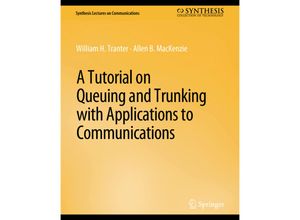The motivation for developing this synthesis lecture was to provide a tutorial on queuing and
trunking with extensions to networks of queues suitable for supplementing courses in
communications stochastic processes and networking. An essential component of this lecture is
MATLAB-based demonstrations and exercises which can be easily modified to enable the student
to observe and evaluate the impact of changing parameters arrival and departure statistics
queuing disciplines the number of servers and other important aspects of the underlying
system model. Much of the work in this lecture is based on Poisson statistics since Poisson
models are useful due to the fact that Poisson models are analytically tractable and provide a
useful approximation for many applications. We recognize that the validity of Poisson
statistics is questionable for a number of networking applications and therefore we briefly
discuss self-similar models and the Hurst parameter long-term dependent models the Pareto
distribution and other related topics. Appropriate references are given for continued study on
these topics.The initial chapters of this book consider individual queues in isolation. The
systems studied consist of an arrival process a single queue with a particular queuing
discipline and one or more servers. While this allows us to study the basic concepts of
queuing and trunking modern data networks consist of many queues that interact in complex
ways. While many of these interactions defy analysis the final chapter introduces a model of a
network of queues in which after being served in one queue customers may join another queue.
The key result for this model is known as Jackson's Theorem. Finally we state the BCMP Theorem
which can be viewed as a further extension of Jackson's Theorem and present Kleinrock's formula
which can be viewed as the network versionof Little's Theorem.Table of Contents: Introduction
Poisson Erlang and Pareto Distributions A Brief Introduction to Queueing Theory Blocking
and Delay Networks of Queues

